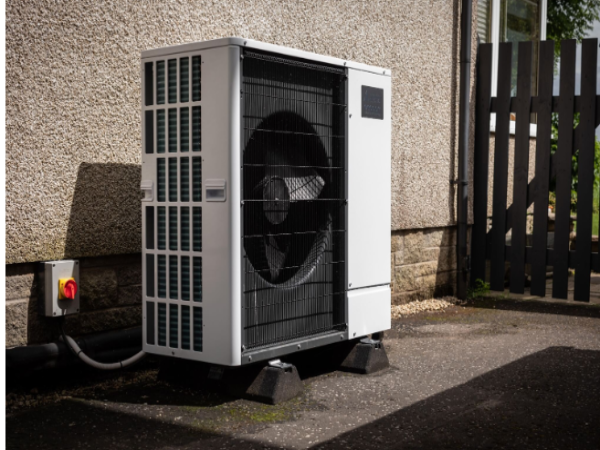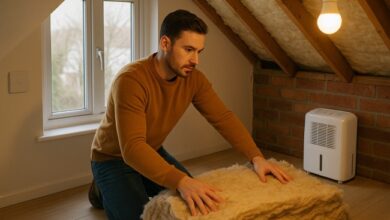What Is an Air Source Heat Pump and How Does It Really Work?

Ever wondered how you could heat your home using nothing but outdoor air? Even when it’s freezing outside? That’s exactly what an air source heat pump (ASHP) does. It’s like having a magic box that pulls warmth from thin air.
Think of it this way: your refrigerator keeps food cold by moving heat from inside to outside. An air source heat pump does the opposite. It grabs heat from outdoor air and brings it inside to warm your home. Pretty clever, right? And with options such as air source heat pump grants UK, making the switch has never been more accessible or affordable.
How Does This Amazing Technology Actually Work?
Let’s break down the heat pump process into simple steps. Don’t worry – it’s not as complicated as it sounds.
The Four-Step Heat Pump Dance
Picture a never-ending cycle that happens right outside your home:
Soaking Up Heat
Your outdoor unit acts like a heat sponge. A special fluid called refrigerant flows through coils and absorbs heat from outside air. Yes, even when it’s -15°C outside, there’s still heat to be found!
Cranking Up the Heat
Next, a compressor squeezes this heated gas. Just like pumping up a bike tire makes it hot, this compression makes the refrigerant super hot.
Sharing the Warmth
The hot refrigerant flows inside your home and releases all that lovely heat. Your rooms get toasty while the refrigerant cools down and turns back into liquid.
Starting Over
The cooled liquid heads back outside, ready to collect more heat. And the cycle starts again.
Need cooling instead? A simple valve flips the whole process backward. Your home becomes the cool zone while heat gets dumped outside.
What Types of Heat Pumps Can You Choose From?
Not all heat pumps work the same way. Let’s explore your two main options and see which might suit your home better.
Air-to-Air Heat Pumps: Direct Air Heating
These systems blow warm or cool air straight into your rooms. Think of them as super-efficient air conditioners that also heat brilliantly.
Why you might love them:
- They cost less to install
- They heat up rooms quickly
- You get both heating and cooling
- No bulky water tanks needed
But here’s the catch:
- You’ll need ducts or wall units in each room
- No hot water for your shower
- They struggle a bit in really cold weather
Air-to-Water Heat Pumps: The Whole-Home Solution
These clever systems heat water that flows through your radiators or underfloor heating. They’re perfect if you already have a wet heating system.
Here’s what makes them great:
- They work with your existing radiators
- You get hot water for baths and dishes
- They handle cold weather better
- Perfect for heating your entire home
The trade-offs:
- Higher upfront costs
- Slower to warm up rooms
- You need space for a hot water tank
Just How Efficient Are These Things?
Here’s where heat pumps really shine. Ready for some impressive numbers?
The Magic of COP (Coefficient of Performance)
Most heat pumps achieve 200-400% efficiency. What does that mean? For every unit of electricity they use, they produce 2-4 units of heat. It’s like getting free energy!
The industry measures this with something called COP. A good heat pump hits a COP of 3.5. That means it produces 3.5 times more heat than the electricity it consumes. Some top models even exceed 4.2. Not bad, right?
Will It Actually Save You Money?
Let’s talk numbers. Who doesn’t want lower energy bills?
Real-World Savings
Depending on your home and current heating system, you could save £280 to £1,400 per year. That’s real money staying in your pocket.
Here’s a quick example: heating an average home might cost £880-£992 annually with a heat pump. The same heating with a gas boiler? Around £1,019-£1,035. Plus, government grants can knock up to £7,500 off your installation costs.
What About the Environment?
Thinking about your carbon footprint? Heat pumps are environmental champions.
A typical air source heat pump produces only 250kg of CO2 per year. Compare that to over 3,500kg from a gas boiler. That’s a massive 90% reduction! Even better, as our electricity grid gets greener, heat pumps become even more eco-friendly.
Can Your Home Handle a Heat Pump?
Before you get too excited, let’s check if your home is ready for this upgrade.
What Your Home Needs
- Space for the Outdoor Unit: You’ll need room outside with good airflow. Think at least 1-2 meters from windows and walls. The unit needs to breathe!
- Proper Electrical Supply: Heat pumps need serious electrical power. You might need an electrician to upgrade your supply.
- Good Insulation: Here’s the big one: your home needs decent insulation. Heat pumps work best in well-insulated homes. Poor insulation means higher running costs.
Getting It Installed Right
Always use MCS-certified installers. These pros know building regulations and safety standards. They’ll handle everything from electrical connections to system setup.
How Much Maintenance Do They Need?
Good news: heat pumps are pretty low-maintenance compared to boilers.
Simple Monthly Tasks
- Clean or change air filters every month or two
- Keep the outdoor unit clear of leaves and debris
- Make sure nothing blocks airflow around the unit
Annual Professional Check
Book a professional service once a year. It keeps warranties valid and your system running smoothly.
With proper care, your heat pump should last 15-25 years. That’s excellent value for money.
Is a Heat Pump Right for You?
Heat pumps offer impressive efficiency, lower running costs, and major environmental benefits. They work even in cold weather and can last decades with proper care.
The key question is: does your home have good insulation and space for installation? If yes, you’re looking at a smart, sustainable heating solution that’ll serve you well for years to come.
Ready to take the next step? Consider getting a professional assessment to see if your home is heat pump-ready. Your wallet and the planet will thank you.



